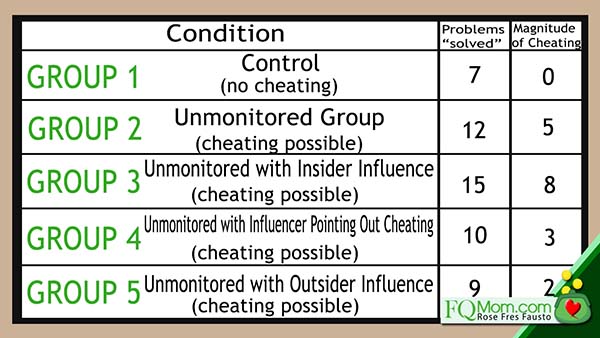Bad behavior is contagious! (and so is good)

A mere reminder of our values can also make us to the right thing even if there are no chances of getting caught.
Last Sunday’s basketball game at the Araneta Coliseum was a spectacle for UAAP (University Athletic Association of the Philippines) followers. It was the final game of the basketball championship between arch rivals, Ateneo de Manila University and De La Salle University. During games like this, we see the best and worst among people. You see foul moves of pinching, elbowing, stepping, some actually involving blood coming out. And these foul moves don’t just come from the players of both teams, but also from their supporters. The sad thing is that, they are parents in their ripe old age of reason.
If there’s such a thing as road rage among drivers, I think there’s also such a thing as UAAP rage among supporters, especially when it’s an Ateneo-La Salle match.

Is this the “UAAP rage?” Instagram/therealdeanquinito
It was a good thing that DLSU posted its campus photo well lit in blue as their gesture of sportsmanship right after ADMU bagged the championship. It was a good PR to them as it was positively shared online by people from both sides. Somehow it made us forget about all the pinching and elbowing that happened during the season.

A good show of sportsmanship from the Green Archers right after the Blue Eagles bagged the championship.
This reminded me of an interesting series of experiments done by rock star Behavioral Economist Dan Ariely together with colleagues to test how we are influenced by the unethical behavior of other people.
The experiment
The researchers gave the students from Carnegie Mellon University a series of Math problems, $10 cash and a sheet to tally the number of problems they could solve in five minutes.
Group 1 – The students submitted their answer sheets to a proctor who tallied their correct answers and instructed them to keep 50 cents for each correct answer and return the balance of the $10. We will call this the control group as there was no opportunity to cheat.
Group 2 – The students were not monitored. They were asked to tally their own scores then shred their tally sheets, and pay themselves 50 cents for each correct answer. Let’s call this the Unmonitored Group where cheating was possible.
I’m sure most of you would know the result of this. There was a 71 percent increase in the average number of correct answers reported by the unmonitored students, which shows that cheating greatly increased. (Note: The participants were randomly chosen so for sure it was not a matter of Group 2 being a lot more intelligent that Group 1). This increase in cheating agrees with a common belief that the incidence of dishonesty and other misbehavior is correlated to the chances of getting caught. This is called SMORC (Simple Model of Rational Crime) – i.e. a cost benefit approach to committing crime where people weigh the probability and magnitude of the gain vs. the probability and magnitude of punishment when caught.
However, dishonesty and other misbehaviors are not as simple as this. As I’ve mentioned several times, humans are not always rational.
Let’s see the rest of the experiment to understand the other factors that affect our behavior.
If you recall in Group 2, the unmonitored group, the participants didn’t know whether the other students would cheat or not. Each one did what he did out of his own. Now here’s what the researchers added to the experiment.
Group 3 – The conditions were similar to Group 2 unmonitored but they hired an actor dressed in plain white t-shirt and looked like a Carnegie Mellon University student. After just 60 seconds into the five minutes allotted to solve the problem, he stood up and said, “I solved everything, my envelop is empty (meaning he already took all the $10, a claim that he solved all 20 items in 60 seconds). What should I do with it?” The proctor said he was free to go. Let’s call this group the Unmonitored, with Insider Influencer.
Group 4 – The conditions were similar to Group 3 but instead of acting out the cheating, he asked the proctor in a loud voice, “Given these instructions, can’t I just say I solved everything and walk away with all the cash? Is this okay?” After pausing for a few seconds, the experimenter answered, “You can do whatever you want.” Let’s call this group the Unmonitored with Influencer Pointing Out Cheating.
Group 5 – The actor wore a University of Pittsburg t-shirt. In Pittsburg, Pennsylvania this is the archrival of Carnegie Mellon University. They are the Ateneo-La Salle in that area. ![]() So the actor did the same thing he did in Group 3 – he stood up to claim that he finished everything correctly in 60 seconds, something that was impossible to accomplish. Let’s call this group the Unmonitored, with Outsider Influencer.
So the actor did the same thing he did in Group 3 – he stood up to claim that he finished everything correctly in 60 seconds, something that was impossible to accomplish. Let’s call this group the Unmonitored, with Outsider Influencer.
Here are the interesting results: In Group 3, 25 percent of the students followed suit submitting and claiming their payment in a few seconds. In fact, the average number of correct answers was 114 percent higher than the control group, signifying that the cheating was even higher compared to Group 2. So there is more at play than the SMORC here.
Guess what happened in Group 4? Only 3.6 percent copied the actor’s behavior. In fact, this group’s average number of correct answers was the lowest among the three unmonitored groups, signifying the least amount of cheating among them. The rival school’s t-shirt served as an antidote to cheating to the participants despite zero chances of getting caught and other negative consequences.
And here’s an interesting result - In Group 4, the average number of correct answers was just a little more than Group 5. This means that if the cheating is pointed out, we are reminded of our values and most of us will not cheat or at least temper the cheating, even if chances of getting caught is zero.

Results from the experiment "Contagion and Differentiation in Unethical Behavior: The Effect of One Bad Apple on the Barrel," Psychological Science by Francesca Gino, Shahar Ayal and Dan Ariely.
The above results show how much we are influenced by our community and circumstances. If the misbehavior comes from someone we identify with, we are most likely to follow suit. But if the behavior comes from an outsider, especially someone we don’t agree with, we tend to do the opposite. But a mere reminder of our values can also make us to the right thing even if there are no chances of getting caught.
So let’s pause and reflect. Who is our community? Who do we identify with? Who do we have opposing values with? How are we affected by their behavior? More importantly, who do we influence with our own behavior? In your office, do you freely take home supplies in full view of your officemates? When you watch basketball games such as the recently concluded UAAP finals, do you curse the rival team and flash your dirty finger? At home, do your children see that you treat your spouse and other family members with love and respect? Do you point out wrongdoings to remind family members about values? Do your children always hear you say, “Wala na naman akong pera!” making it an acceptable thing to always run out of money?
Remember, we affect each other’s behavior. Inasmuch as bad behavior is contagious, the same goes for good behavior. So let’s practice more of the good - amplify them, share them in the hope of causing positive behavior contagion to combat the negative ones. ![]()
*******************************
ANNOUNCEMENT
Want to know your FQ score? Take it today. Click link to take the test. http://tinyurl.com/FQTest

Rose Fres Fausto is a speaker and author of bestselling books “Raising Pinoy Boys” and “The Retelling of The Richest Man in Babylon” (English and Filipino versions). Click this link to read samples – Books of FQ Mom Rose. She is a behavioral economist, a certified gallup strengths coach and the grand prize winner of the first Sinag Financial Literacy Digital Journalism Awards. Follow her on Facebook and You Tube as FQ Mom, and Twitter & Instagram as theFQMom.



















